Related Research Articles
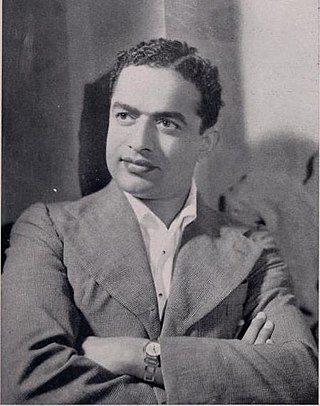
Shantaram Rajaram Vankudre, referred to as V. Shantaram or Shantaram Bapu, was an Indian filmmaker, film producer, and actor known for his work in Hindi and Marathi films. He is most known for films such as Dr. Kotnis Ki Amar Kahani (1946), Amar Bhoopali (1951), Jhanak Jhanak Payal Baaje (1955), Do Aankhen Barah Haath (1957), Navrang (1959), Duniya Na Mane (1937), Pinjara (1972), Chani, Iye Marathiche Nagari and Zunj.
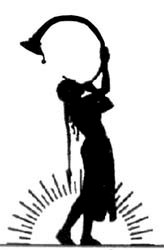
Prabhat Film Company was an Indian film production company and film studios founded in 1929 by the noted film director V.Shantaram and his friends.
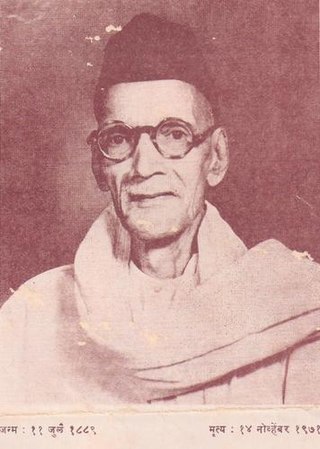
Narayan Hari Apte, popularly known as Nanasaheb Apte was a Marathi popular novelist, writer of advice books and editor from Maharashtra, India.
Maharashtra Film Company was an Indian film production company, established by Baburao Painter in Kolhapur. Established in 1918, it was a silent film studio, which was a pioneer in Maharashtra and Marathi cinema, under the patronage of the Shahu Maharaj, the Maharaja of Kolhapur. It released the first significant historical, Sairandhari, released in Pune 7 February 1920. In the coming decade the only other major company was Dada Saheb Phalke's Hindustan Film Company. It made numerous films till the advent of talkies in 1931, but started collapsing after V. Shantaram left in 1929, to form Prabhat Film Company, it finally closed down in 1931.
Vishnupant Govind Damle was an Indian production designer, cinematographer, film director and sound engineer for Marathi films. His 1937 film Sant Tukaram was the first Indian film to be screened at an international film festival. It won a "Special Recommendation" at the 5th Venice International Film Festival.
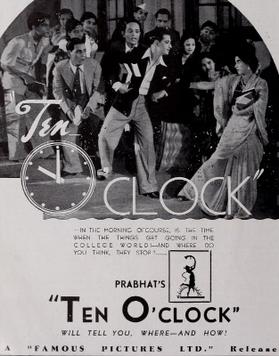
Das Baje, also called 10 O'Clock, is an Indian film. It was released in 1942. This was a debut direction for Raja Nene, a protege of V. Shantaram, and produced under Shantaram's Prabhat Film Company banner. The film was a bilingual, made in Hindi, and in the Marathi language as Daha Wajta. The music direction was by Keshavrao Bhole. The story was written by Kashyap and Pawar, with dialogues in Hindi by Ashant. The photography was by E. Mohammed. It starred Paresh Bannerji, Urmila and Vasant Thengdi in the lead roles, with Baby Shakuntala and Manajirao forming the supporting cast.

Amrit Manthan is a 1934 Indian costume-drama film directed by V. Shantaram for his Prabhat Film Company. The film was produced simultaneously in Hindi and Marathi. The film starred Chandra Mohan, Nalini Tarkhad, Shanta Apte, G. R. Mane, Varde and Kelkar. The film was based on Narayan Hari Apte's novel Bhagyashree. The Hindi translation was done by Veer Mohammed Puri, who also wrote the lyrics for the film.
Netaji Palkar is a 1927 Indian biopic historical silent film directed by V. Shantaram. Kaishavrao Dhaiber who was an apprentice with Damle, co-directed the film. He was to become the chief cinematographer for Shantaram in his later films. Made under the Maharashtra Film Company, Kolhapur, it was the first film directed by Shantaram. The director of photography was S. Fattelal and the cast included Ansuya, Balasaheb Yadav, Ganpat Bakre and Zunzarrao Pawar.
Gopal Krishna is an Indian religious silent film made in 1929. It was directed by V. Shantaram for his newly formed Prabhat Film Company. The film was a "solo debut" for Shantaram, after co-directing Netaji Palkar (1927) with K. Dhaiber for the Maharashtra Film Company. The story was written by Shivram Vashikar and the cast composed of Suresh, Kamaladevi, Anant Apte, Sakribai and G.R. Mane.

Udaykal is a 1930 historical silent film co-directed by V. Shantaram and Keshavrao Dhaiber. It was produced by Prabhat Film Company. The story was written by Baburao Pendharkar. The cinematographers were S. Fattelal and V. G. Damle. The film starred V. Shantaram, Baburao Pendharkar, Kamla Devi, G. R. Mane, Ibrahim and Dhaiber.

Sinhagad is a 1933 Marathi historical fact film directed by V. Shantaram. The production company was Prabhat Film Company. The story was based on Hari Narayan Apte's literary classic novel "Gad Ala Pan Sinha Gela". Apte was a famous Marathi novelist of the early twentieth century. The story's screenplay and dialogue were written by Narayan Hari Apte. The cinematographers were V. Avadhoot and Keshavrao Dhaiber. The cast included Master Vinayak, Baburao Pendharkar, Keshavrao Dhaiber, Leela Chandragiri, Shinde, Prabhavati, Budasaheb and Shankarrao Bhosle.

Ladki Sahyadri Ki is a 1966 Hindi social drama film directed by V. Shantaram. Also called Iye Marathichiye Nagari in Marathi, it was a bilingual for V. Shantaram productions under the Rajkamal Kalamandir banner. The music was composed by Vasant Desai, with lyrics by Bharat Vyas. The cast included Sandhya, Shalini Abhyankar, Vatsala Deshmukh, Kumar Dighe, Keshavrao Date, and Baburao Pendharkar.
Khooni Khanjar is a 1930 Indian silent film directed by V. Shantaram. The film was a costume action drama film co-directed by Keshavrao Dhaiber. It was produced by Prabhat Film Company. The cinematography was by Sheikh Fattelal and Vishnupant Govind Damle. The cast included Mane Pahelwan, Ganpat G. Shinde, P. Jairaj, Sakribai and Shankarrao Bhosle.

Manoos, also called Life's for Living, is a 1939 Indian Marathi social melodrama film directed by V. Shantaram. The movie was simultaneously made in Hindi as Aadmi. The film was based on a short story called "The Police Constable". The story was by A. Bhaskarrao, with screenplay and dialogue by Anant Kanekar. The cinematographer was V. Avadhoot and the music was composed by Master Krishna Rao, with lyrics by Kanekar. The cast included Shahu Modak, Shanta Hublikar, Sundara Bai, Ram Marathe, Narmada, Ganpatrao and Raja Paranjpe.
Chandrasena is a 1931 Indian silent film directed by V. Shantaram and Keshavrao Dhaiber. The director of photography was Keshavrao Dhaiber. Produced under the banner of Prabhat Film Company, the film brought the company into the "frontline" of film makers. The cast included Lila, "alias" Lilavati Pendharkar, who was making her debut with this film, with Kamla, Gulabbai and G. R. Mane.
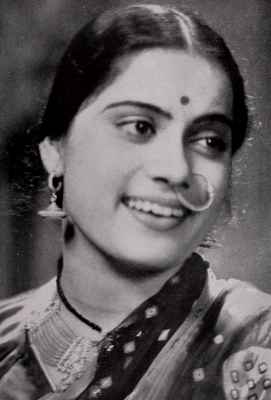
Shanta Apte (1916–1964) was an Indian actress-singer who worked in Marathi and Hindi cinema. Renowned for her roles in films like Duniya Na Mane/Kunku (1937) and Amar Jyoti (1936) under the Prabhat Films banner, she was active in Indian cinema from 1932 to 1958. Apte's impact on Marathi cinema "paralleled" that of Kanan Devi in Bengali cinema. Along with Kanan Devi, Apte is cited as one of the "great singing stars" from before the playback singing era. Apte began her career in films playing the role of a young Radha in the Marathi film Shyamsunder (1932). She joined Prabhat Films acting in her first Hindi language film Amrit Manthan in (1934).
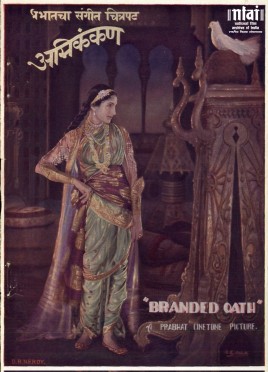
Agnikankan: Branded Oath also called The Branded Oath, is a 1932 Marathi adventure film directed by V. Shantaram. The film was a Prabhat Film Company production and was a bilingual, called Jalti Nishani in Hindi. The cinematography was done by Keshavrao Dhaiber and Art direction by S. Fatehlal. The sound direction was by Vishnupant Govind Damle and the music and lyrics were by Govindrao Tembe. Dialogues for the movie are written by Govindrao Tembe. The character artist Gajanan Jagirdar began his career in films by acting the role of a seventy-five-year-old man at the age of twenty-five. The cast included Shankarrao Bhosle, Kamala Devi, Master Vinayak, Baburao Pendharkar, Nimbalkar and Jagirdar.
Sairandhari is a 1920 Indian film based on an episode from the Mahabharata and directed by Baburao Painter and Produced by Maharashtra Film Company. V. Shantaram remade it as Sairandhri in 1933.
References
- ↑ Ashish Rajadhyaksha; Paul Willemen (10 July 2014). Encyclopedia of Indian Cinema. Taylor & Francis. pp. 7–. ISBN 978-1-135-94325-7 . Retrieved 12 February 2015.
- ↑ Lindsay Anderson (12 November 2013). Lindsay Anderson Diaries. A&C Black. pp. 99–. ISBN 978-1-4081-5009-2 . Retrieved 12 February 2015.
- ↑ "Rani Saheba (1930)". indiancine.ma. IndianCine.ma. Retrieved 12 February 2015.
- ↑ "Rani Saheba (1930)". citwf.com. Alan Goble. Retrieved 12 February 2015.
- ↑ B D Garga (1 December 2005). Art Of Cinema. Penguin Books Limited. pp. 66–. ISBN 978-81-8475-431-5 . Retrieved 12 February 2015.
- ↑ Prof. R. P. Chaturvedi (1 September 2010). Great Personalities. Upkar Prakashan. pp. 386–. ISBN 978-81-7482-061-7 . Retrieved 12 February 2015.
- ↑ Sanjit Narwekar; Raghuvir Kul; D. B. Samant (1995). Marathi Cinema: in retrospect. Maharashtra Film, Stage & Cultural Development Corporation.